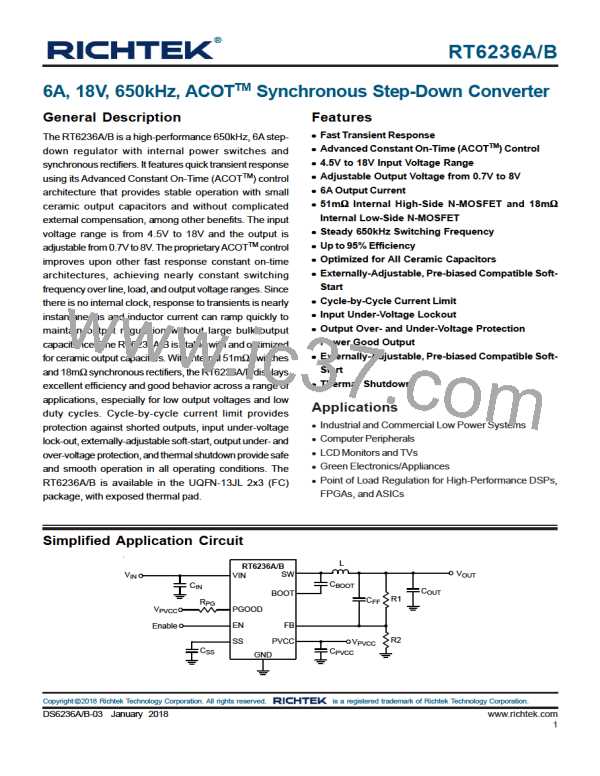RT6236A/B
control schemes suffer from some disadvantages that
preclude their use in many cases. Many applications require
a known switching frequency range to avoid interference
with other sensitive circuitry. True constant on-time control,
where the on-time is actually fixed, exhibits variable
switching frequency. In a step-down converter, the duty
factor is proportional to the output voltage and inversely
proportional to the input voltage. Therefore, if the on-time
is fixed, the off-time (and therefore the frequency) must
change in response to changes in input or output voltage.
rise to the input voltage. This increases the effective on
time and causes the switching frequency to drop
noticeably.
One way to reduce these effects is to measure the actual
switching frequency and compare it to the desired range.
This has the added benefit eliminating the need to sense
the actual output voltage, potentially saving one pin
connection. ACOTTM uses this method, measuring the
actual switching frequency and modifying the on-time with
a feedback loop to keep the average switching frequency
in the desired range.
Modern pseudo-fixed frequency COT architectures greatly
improve COT by making the one-shot on-time proportional
to VOUT and inversely proportional to VIN. In this way, an
on-time is chosen as approximately what it would be for
an ideal fixed-frequency PWM in similar input/output
voltage conditions. The result is a big improvement but
the switching frequency still varies considerably over line
and load due to losses in the switches and inductor and
other parasitic effects.
To achieve good stability with low-ESR ceramic capacitors,
ACOTTM uses a virtual inductor current ramp generated
inside the IC. This internal ramp signal replaces the ESR
ramp normally provided by the output capacitor's ESR.
The ramp signal and other internal compensations are
optimized for low-ESR ceramic output capacitors.
ACOTTM One-Shot Operation
Another problem with many COT architectures is their
dependence on adequate ESR in the output capacitor,
making it difficult to use highly-desirable, small, low-cost,
but low-ESR ceramic capacitors. Most COT architectures
use AC current information from the output capacitor,
generated by the inductor current passing through the
ESR, to function in a way like a current mode control
system. With ceramic capacitors the inductor current
information is too small to keep the control loop stable,
like a current mode system with no current information.
The RT6236A/B control algorithm is simple to understand.
The feedback voltage, with the virtual inductor current ramp
added, is compared to the reference voltage. When the
combined signal is less than the reference and the on-
time one-shot is triggered, as long as the minimum off-
time one-shot is clear and the measured inductor current
(through the synchronous rectifier) is below the current
limit. The on-time one-shot turns on the high-side switch
and the inductor current ramps up linearly. After the on
time, the high-side switch is turned off and the synchronous
rectifier is turned on and the inductor current ramps down
linearly. At the same time, the minimum off-time one-shot
is triggered to prevent another immediate on-time during
the noisy switching time and allow the feedback voltage
and current sense signals to settle. The minimum off-time
is kept short (230ns typical) so that rapidly-repeated on-
times can raise the inductor current quickly when needed.
ACOTTM Control Architecture
Making the on-time proportional to VOUT and inversely
proportional to VIN is not sufficient to achieve good
constant-frequency behavior for several reasons. First,
voltage drops across the MOSFET switches and inductor
cause the effective input voltage to be less than the
measured input voltage and the effective output voltage to
be greater than the measured output voltage. As the load
changes, the switch voltage drops change causing a
switching frequency variation with load current. Also, at
light loads if the inductor current goes negative, the switch
dead-time between the synchronous rectifier turn-off and
the high-side switch turn-on allows the switching node to
Discontinuous Operating Mode (RT6236A Only)
After soft-start, the RT6236A operates in fixed frequency
mode to minimize interference and noise problems. The
RT6236A uses variable-frequency discontinuous switching
at light loads to improve efficiency. During discontinuous
switching, the on-time is immediately increased to add
Copyright 2018 Richtek Technology Corporation. All rights reserved.
©
is a registered trademark of Richtek Technology Corporation.
www.richtek.com
4
DS6236A/B-03 January 2018

 RICHTEK [ RICHTEK TECHNOLOGY CORPORATION ]
RICHTEK [ RICHTEK TECHNOLOGY CORPORATION ]